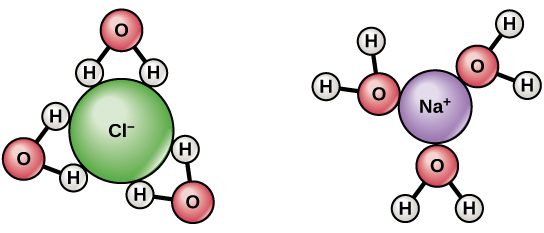1+1 = 2, exactly. Other than that, use of the term "exactly" and similar terms like "absolutely" should be avoided in technical discussions. Also, while I understand what you meant, its quite unlikely that most 5 year olds are capable of understanding such abstract concepts, but I digress...
The ions increase the average particle-to-particle (p2p) attractive forces in the aqueous solution, which means that more energy is required to increase the surface area (bring a particle from the interior (bulk) to the interface. The traditional example is comparing the bond energy of a ion in a cubic closest packed (6 nearest neighbors in a "square" 3D grid) (so it has a total bond energy of $6x$, where $x$ is the energy of a single bond) to the same type of ion at the surface of a (large) lattice - at the surface, one bond will be missing ($5x$). (This is a simplification, since it ignores all electrostatic forces (both repulsive and attractive) of ions not 'nearest neighbor'.)
Of course, in the real world surface energy/tension considerations are usually concerned with at least two phases (eg liquid & gas in aerosols) and often three (eg. water wetting the side of a glass container in air). You can imagine that the measured surface tension could be different if measured in helium compared to the surface tension of the same substance measured in carbon dioxide. The link you provided to the reddit had some correct information, but then it went off the rails when it discussed detergents. It's wrong, there. The stackexchange Q&A link you provided seems to me to be a correct point of view, but I don't find it useful, do you? The same argument applies at the surface as in bulk (for small solute molecules and ions). The ion must have a solvation sheath (a coat of solvent molecules) to 'insulate' the charge, otherwise it wouldn't go into solution. (This applies to polar solvents (and water is both polar and a strong hydrogen-bonding molecule)). It should be clear that if the ion were at the surface, that it wouldn't have as "thick" a coat so it will tend to avoid it.
Keep careful track of each argument's scale. Talking about a lattice of ions is considering a much smaller scale than a coated ion in solution. By that I mean the word "surface" means different things at those two scales. In the former (crystalline solid) it is the outermost ions of the lattice, while in the latter it is a zone of multiple solvent molecule diameters depth, with the molecules and ions bouncing around, and forming only intermittent (secondary as in intermolecular, non-covalent, non-ionic) bonds.
Detergent molecules are generally much larger, and they usually have a non-polar tail which doesn't interact with water (hydrophobic) and a polar head (which has much more interaction with water (meaning it increases the secondary bonding energy of the system)). These molecules orient themselves at the surface and so for (most) detergent solutions, the surface is highly enriched with them. They use this fact to coat mono molecular films (one molecule thick) onto glass. So, it is not true that ions aren't to be found at the surface of the solution, but it is true that their concentration there will be less (and depend on temperature). The key fact is that they increase average intermolecular bond energy of the solution.

